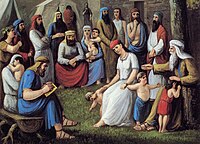Limhi
Limhi Nephite king in the Book of Mormon | |
|---|---|
 As depicted in Ammon Arrested by the Guards of King Limhi (c. 1924) | |
| Era | Before the reign of the judges |
| Known for | Last king of the Nephite colony in the land of Lehi-Nephi |
| Predecessor | King Noah |
In the Book of Mormon, Limhi (/ˈlɪmhaɪ/)[1] is the third and final king of the second Nephite habitation of the land of Lehi-Nephi. He succeeds his father, Noah. Led by Ammon (a descendant of Zarahemla), Limhi and his people escape from the Lamanites with his people to the land of Zarahemla.
Synopsis
[edit]| Part of a series on |
| People in the Book of Mormon |
|---|
 |
After the death of their previous king, Noah, the surviving members of the Nephite colony living in the land of Lehi-Nephi appoints one of his sons, Limhi, to the throne.[2] Living under occupation by a Lamanite army, Limhi's colonists attempt three violent revolts, all of which the Lamanites quash.[3]
When a band of Nephites from Zarahemla, led by an explorer named Ammon, rediscover the Lehi-Nephi colony, Limhi gathers his community, and he and Ammon read and recite their respective people's histories to each other and before the convocation.[4]
Resolving to escape subjugation, Limhi consults with Ammon about what to do, and Gideon, an advisor, devises a plan to intoxicate and incapacitate the Lamanite guards with a gift of alcohol. The plan is successful, enabling Limhi and his people to flee the land of Lehi-Nephi and travel with Ammon to Zarahemla.[5]
On reaching Zarahemla, Limhi exchanges histories with King Mosiah, ruler of the Nephites there, and their peoples unite.[6]
Reception
[edit]Visual art
[edit]
American artist George M. Ottinger's painting Baptism of Limhi, depicting the Mosiah 25:17–18 scene of Alma baptizing Limhi, was completed in 1872 and displayed at the Utah Territorial State Fair that year.[7] The full painting was seven and a half feet by five feet.[8] A version of this image, likely less detailed than the original was, was later published as an illustration in the 1888 The Story of the Book of Mormon.[9]
In approximately 1883, landscape painter Reuben Kirkham produced a panorama of Book of Mormon scenes (the location or survival of which are unknown) which included Last Battle of King Limhi and The Last Battles of the People of Limhi.[10]
Namesakes
[edit]Nineteenth-century Latter-day Saint settlers in territorial Oregon named Fort Limhi after king Limhi.[11] They also named the Lemhi River after the Book of Mormon king's name (albeit misspelled).[12] Lemhi County, Idaho receives its name from a misspelling of Limhi.[13]
See also
[edit]Citations
[edit]- ^ churchofjesuschrist.org: "Book of Mormon Pronunciation Guide" (retrieved 2012-02-25), IPA-ified from «lĭm´hī»
- ^ Gee (1992, pp. 54–55, 60–61).
- ^ Hardy (2010, p. 167).
- ^ Bushman (2004, p. 69).
- ^ Hardy (2010, p. 167); Austin (2024, p. 83).
- ^ Bushman (2004, pp. 69–70).
- ^ Carmack (2008, pp. 120–121).
- ^ Carmack (2008, p. 120).
- ^ Carmack (2008, p. 121).
- ^ Poulton (2012, pp. 124, 203).
- ^ Hartley (2001, p. 139); Bigler (2003, p. 25).
- ^ Hartley (2001, p. 139); Garner (2019, paragraph 2).
- ^ Bigler (2003, p. 25).
References
[edit]- Austin, Michael (2024). The Testimony of Two Nations: How the Book of Mormon Reads, and Rereads, the Bible. University of Illinois Press. ISBN 9780252045356.
- Bigler, David L. (2003). Fort Limhi: The Mormon Adventure in Oregon Territory, 1855–1858. Kingdom in the West: The Mormons and the American Frontier. Arthur H. Clark. ISBN 0-87062-324-9.
- Bushman, Richard Lyman (2004). "The Book of Mormon in Early Mormon History". In Neilson, Reid L.; Woodworth, Jed (eds.). Believing History: Latter-day Saint Essays. Columbia University Press. pp. 65–78. ISBN 0-231-13006-6.
- Carmack, Noel A. (2008). "'A Picturesque and Dramatic History': George Reynolds's Story of the Book of Mormon". Brigham Young University Studies. 47 (2): 115–141. JSTOR 43044637.
- Garner, Bridget (February 12, 2019). "The Rise and Fall of Fort Limhi". Intermountain Histories.
- Gee, John (1992). "Limhi in the Library". Journal of Book of Mormon Studies. 1: 54–66. doi:10.2307/44758621.
- Hardy, Grant (2010). Understanding the Book of Mormon: A Reader's Guide. Oxford University Press. ISBN 9780199745449.
- Hartley, William G. (Fall 2001). "Dangerous Outpost: Thomas Corless and the Fort Limhi/Salmon River Mission". Mormon Historical Studies. 2 (2): 135–162.
- Poulton, Donna L. (2012). Reuben Kirkham: Pioneer Artist. Cedar Fort. ISBN 978-1599553801.
Further references
[edit]- Hardy, Heather (2007). "Another Testament of Jesus Christ: Mormon's Poetics". Journal of Book of Mormon Studies. 16 (2): 16–27, 93–95. doi:10.5406/jbookmormstud.16.2.0016.
